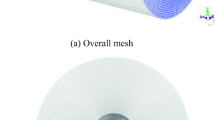Abstract
Numerical simulations of the flow around two bidirectional staggered propellers are conducted in uniform flow. The computed open water performance of the fore-propeller is compared with the corresponding experimental results, and the influence of the fore-propeller on the aft one is carefully investigated. It is found that the inflow around the aft propeller close to the side of the fore is especially affected by the fore one, leading to abnormal circumferential distribution of force on the blade in the shade region. For either forces or velocity distributions, the abnormal changes behave contrarily for cases with the rotating speed larger or smaller than the idle. Moreover, the more the rotating speed of the fore differs from the idle, the larger the abnormal values become.
Similar content being viewed by others
References
FUNENO I., NOZAWA K. Analysis of steady viscous flow around a highly skewed propeller [J]. Journal of Kansai Society of Naval Architects, 1999, 231: 1–6.
FUNENO I. Analysis of unsteady viscous flow around a highly skewed propeller [J]. Journal of Kansai Society of Naval Architects, 2002, 2371: 39–45.
LI Da-Qing. Validation of RANS predictions of open water performance of a highly skewed propeller with experiments [J]. Journal of Hydrodynamics, Ser. B, 2006, 18(3 Suppl.): 520–528.
LIU Zhi-hua, XIONG Ying and YE Jin-min. et al. Study on the prediction of propeller open-water perfor-mance using RANS formula and multi-block hybrid meshes [J]. Journal of Hydrodynamics, Ser. A, 2007, 22(4): 450–456(in Chinese).
CHEN B., STERN F. Computational fluid dynamics of four quadrant marine-propulsor flow [J]. Journal of Ship Research, 1999, 43(4): 218–228.
CHEN H. C., LEE S. K. Time-domain simulation of four quadrant propeller flows by a Chimera moving grid approach [C]. Proceedings USCE Conference: Ocean Engineering in the Oceans VI, Baltimore, USA, 2004, 177–191.
WATANABE T., KAWAMURA T. and TAKEKOSHI T. et al. Simulation of steady and unsteady cavitation on a marine propeller using a RANS CFD code [C]. Fifth International Symposium on Cavitation (CAV2003). Osaka, Japan, 2003, GS-12-004.
XIONG Ying, YE Jin-ming and WANG De-xun. Prediction of unsteady cavitation of propeller using surface panel method [J]. Journal of Hydrodynamics, Ser. B, 2005, 17(1): 43–49.
ABDEL-MAKSOUD M., MENTER F. R. and WUTTKE H. Numerical computation of the viscous flow around the series 60 CB = 0.6 with rotating propeller [C]. 3rd Osaka Colloquium on Advanced CFD Applications to Ship and Hull Form Design. Osaka, Japan, 1998.
KIM Ki-Han. Simulation of surface ship dynamics using unsteady RANS codes [C]. RTO AVT sympo-sium on “Reduction of Military Vehicle Acquisition Time and Cost through Advanced Modeling and Virtual Simulation”. Paris, France, 2002, 22–25.
STRECKWALL H., GATCHELL S. and TIGGES K. A complete numerical model for podded propulsion [C]. 9th Internationl Symposium on Practical Design of Ships and Other Floating Structures. Lübeck-Travemünde, Germany, 2004.
PONTAZA J. P, CHEN H. C. and LEE S. K. Chimera Reynolds-Averaged Navier-Stokes simulations of coupled ship and propeller flows [C]. Proceedings of the Sixteenth International Offshore and Polar Engineering Conference. San Francisco, California, USA, 2006, 468–474.
CAI Rong-quan, FENG Xue-mei and CHEN Feng-ming. The numerical computation and analysis of the open water performance of a propeller using Fluent [J]. Journal of Ship Mechanics, 2006, 10(5): 41–48(in Chinese).
FENG Xue-mei, CAI Rong-quan and WANG Jin-ba. et al. The numerical simulation of the flow field around a propelled hull including free surface influence [J]. Ship-building of China, (Selected Papers of The Chinese Society of Naval Architects and Marine Engineers), 2005-2006, 17: 11–23.
WANG Jin-bao, CAI Rong-quan and FENG Xue-mei. Practical research on viscous flow around container ship taking into account the effect of free surface and prope-ller rotation [J]. Journal of Hydrodynamics, Ser. A, 2007, 22(4): 491–500(in Chinese).
BLASE E. L., MARCUM D. L. A sliding interface method for unsteady unstructured flow simulations [J]. International Journal for Numerical Methods in Fluids, 2007, 53(3): 507–529.
Author information
Authors and Affiliations
Corresponding author
Additional information
Biography: FENG Xue-mei (1976-), Female, Ph. D., Engineer
Rights and permissions
About this article
Cite this article
Feng, Xm., Lu, Cj., Wu, Q. et al. Numerical Researches on Interaction Between Propellers in Uniform Flow. J Hydrodyn 24, 675–683 (2012). https://doi.org/10.1016/S1001-6058(11)60291-6
Received:
Revised:
Issue Date:
DOI: https://doi.org/10.1016/S1001-6058(11)60291-6




